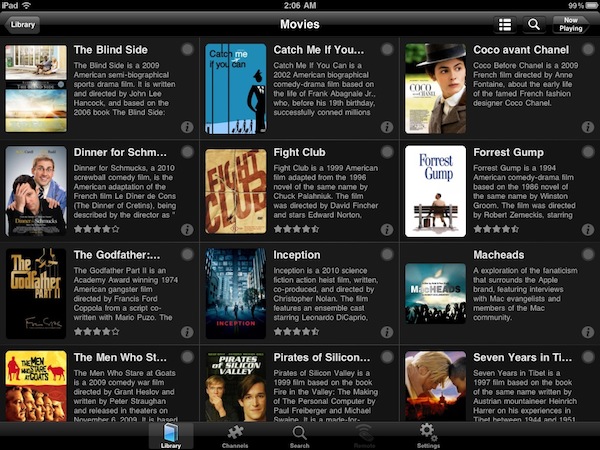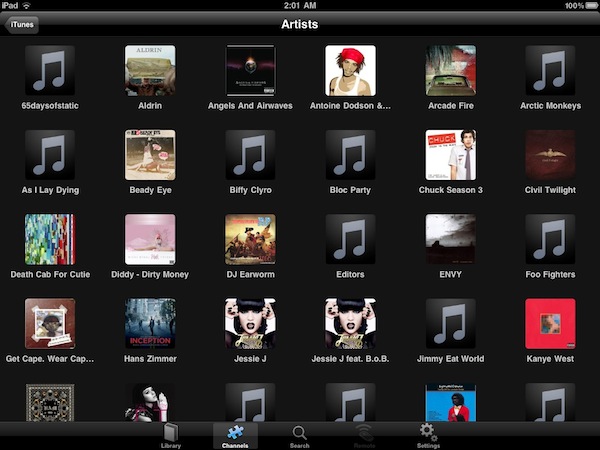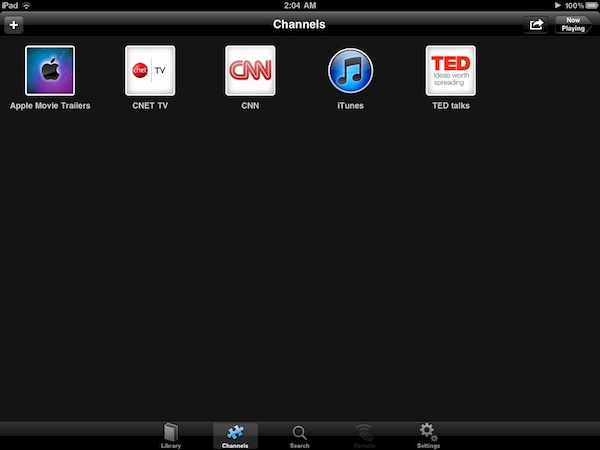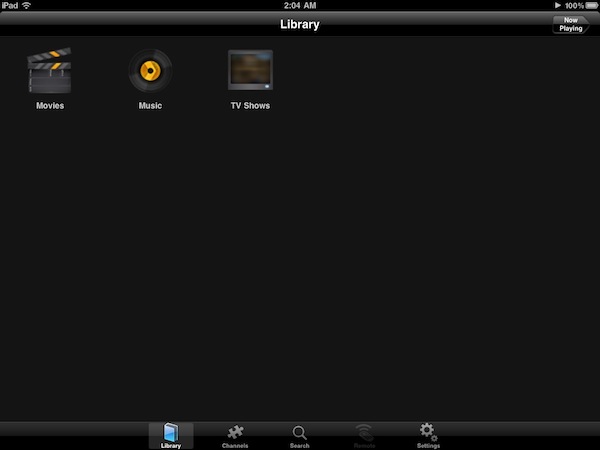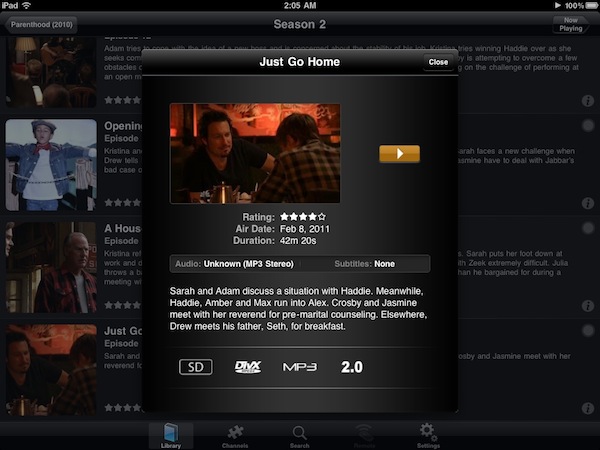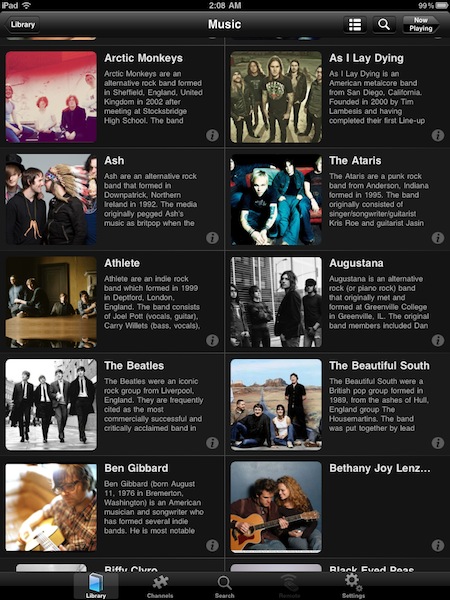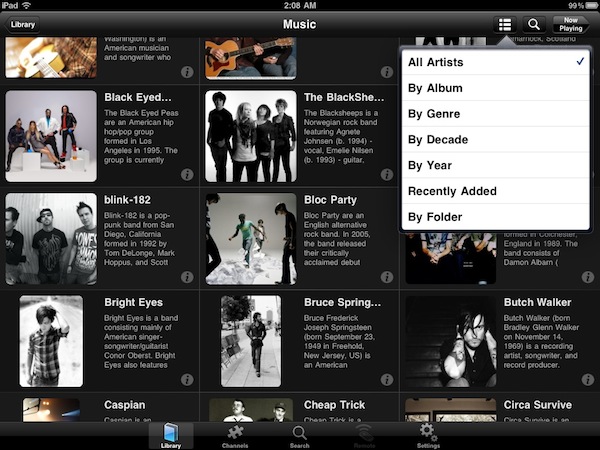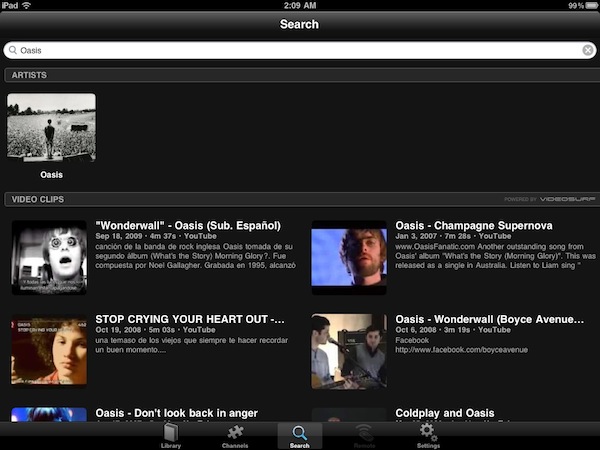If you’re serious about your media library, you’ve probably heard of Plex: dubbed as the “solution for local and online media”, Plex is a fantastic multi-platform media center that runs on Macs and Windows PCs and has great iOS and Android clients. Once installed on your desktop machine (which becomes a “server”) Plex can fetch music, movies and TV shows stored on your computer or anywhere else on an external hard drive, organize them properly into categories by adding the correct metadata, and handle streaming to the clients (such as the iPhone or iPad apps) with live conversion of unsupported video formats. All your media can also be played locally on a computer without the need of a mobile client thanks to the desktop Plex app, which is highly customizable: you can add your own themes, install plugins (like Spotify) and connect to online content providers such as the CNN, Vimeo, Cnet TV, Youtube, Apple Movie Trailers and many others. If that’s not enough for you, Plex can also enable you to connect to your media library remotely via WiFi or 3G with a global hostname, through the iOS apps.
There is no doubt Plex is the most powerful media center currently available on OS X, with tons of options and settings to choose from, and powerful remote login capabilities that put your media library in your pockets all the time. For quite some time I’ve been using the Plex iOS app to watch movies on the couch at home, and stream music via 3G while on the go. The iOS app was good, with a good selection of settings and an easy-to-use interface that allowed me to quickly browse my music library, or find the Lost episode I wanted to watch. But this is all getting a lot better today with the release of Plex 1.1 for iOS – a massive update of the iPhone and iPad clients that takes a leap forward in delivering high quality videos anywhere on all kinds of configurations, and giving you the tools to search for any kind of content both locally or online directly with your iOS devices.
Following a series of updates for the desktop application that enabled Search, smart subtitle recognition and a bunch of other features like FLAC scanning and authentication in the web media manager, Plex 1.1 for iOS adds several improvements to the original app released in November 2010. Plus a totally new user interface with (finally) a beautiful grid view that makes it incredibly easy to get an overview of all your music and video files. The dashboard got a new grid option as well, and of course there’s also Search in the mix.
Interface changes aside (just take a look at the screenshots in this post), let’s start with the two features that immediately caught my attention: the unified Channel management and Search. Thanks to a collaboration with web service VideoSurf, the Search tab in the Plex app allows you to search for content both locally, on your server, and online. This means the app will return results for music or videos found in your house, as well as videos from Youtube and Vimeo. But there’s more: the new Search functionality also looks for content on all the Plex media servers in your house – not just the one you’re connected to – and is available on the desktop as well. The devs promise more content providers will be added soon, and I’m happy to report Search is as fast as it gets in finding content, and displaying relevant results from the two websites mentioned above. If you’re hungry for online content, the new Channels tab should give you plenty of media to watch and listen to: usual iTunes integration aside (that’s right, you can stream your iTunes library through Plex), you can easily add dozens of channels like Apple Movie Trailers, TED talks or CNN and navigate through them with the new grid interface. Every channel offers different options and settings, and when you get to the actual video files hosted online you’ll get another awesome grid view with thumbnails, info, and more. Tap on an item, and start playing on your iPhone or iPad. If you want, you can activate the experimental AirPlay integration in the Preferences and beam everything to an Apple TV or AirPlay speaker. All within Plex, from an iOS device connected to the Internet both on WiFi or 3G. Channels can be managed, updated, uninstalled – you can also organize the metadata agents that Plex uses to gather media info from Wikipedia or Rotten Tomatoes. Plex is an intuitive app, but it gets serious if you truly want to manage your media or search for interesting online content. It doesn’t get any better than this in my opinion. Oh and, by the way, Plex 1.1 also got TV-out support. Just so you know.
Moving on to other features introduced in 1.1 – and before the big one I’ve saved for the last part of this article – there are lots of minor enhancements here and there: the Remote interface has been updated on the iPad with volume buttons and landscape support; the headphone button can be used to play/pause; local image caching has been implemented for faster browsing on 3G; several issues have been fixed. Overall, the app feels a lot more stable and faster, especially when streaming video.
Which brings me to my last point about the huge improvement in Plex 1.1: the transcoding engine that handled conversions of unsupported media formats to the iOS client has been rewritten to accommodate two new features that dramatically improve the speed and quality of video: Direct Play and Direct Streaming. Whilst Direct Play makes sure that an already “properly encoded” video file gets served to an iOS device without any actual conversion (if you have an MP4 file encoded for iOS, there’s no need to convert – it just plays), Direct Streaming involves some advanced H.264 integration that allows for low CPU usage, and better picture quality overall. How so? iOS and Android devices come with integrated hardware chips to decode video, and the new Plex app takes advantage of this to deliver content optimized for an iPhone or iPad with a process that’s faster and lighter than the previous transcoding.
The developers explain with a blog post:
For this reason, we’ve introduced a feature called Direct Streaming, As you might know, the current standard for web video is H.264 (regardless of how Google tries to undermine it); this codec happens to be the most common inside an MKV file, and also the most commonly supported on mobile devices. Android and iOS devices support decoding H.264 in hardware directly.
What you might not know is that the iOS devices (especially the latest generation, including the ATV2) have incredibly powerful little chips inside them for decoding video. Even though the specs say they are capable of 720p, it turns out that they do a good job with a lot of 1080p content as well. So when a client connects to the Plex Media Server, it describes its capabilities, and if the file falls within the acceptable range, the video is simply copied over to the new format (a process known as re-muxing). This again means that there is very little CPU used on the server side, and no loss in quality in the video.
So, Plex 1.1 for iOS. What started as a pretty good way to stream content from a media center to an iPhone or iPad has become a full-featured solution to browse local and online video, listen to music, get detailed information and, most of all, receive high-quality video files thanks to the new streaming technologies implemented in version 1.1. Plex is a must-have, and I honestly don’t know how the app could get better than this with a future update. So go buy it now in the App Store (it’s only $4.99, universal), download Plex for Mac from the official website and enjoy a better way to manage, play and browse media on iOS.
More screenshots below.


